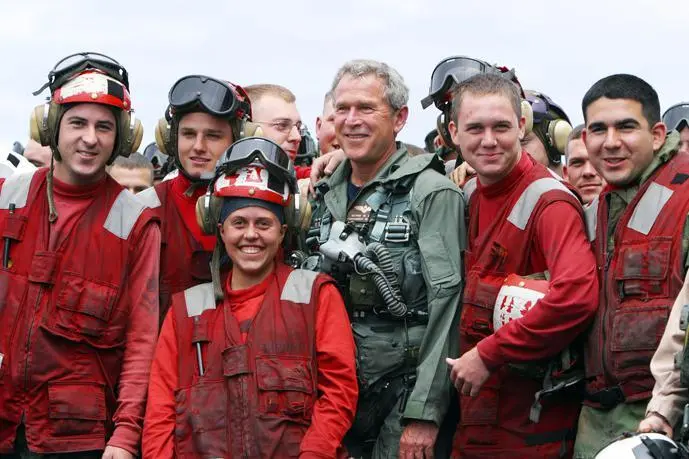When the meeting ended, Dan Bartlett told me I ought to take a look at the TV. I didn’t keep one in the Oval Office, so I went to the area outside where my personal assistants sat. I watched as a crowd of Iraqis in Baghdad’s Firdos Square cheered while a Marine vehicle dragged down a forty-foot-tall statue of Saddam.
For twenty days I had been filled with anxiety. Now I was overwhelmed with relief and pride. I was also mindful of the challenges ahead. Saddam’s forces still controlled parts of northern Iraq, including his hometown of Tikrit. There were pockets of resistance from ruthless Baathist fighters called Fedayeen Saddam. And Saddam and his sons were on the run. As I told José Maria Aznar when I called to share the news, “You won’t see us doing any victory dances or anything.”

I should have followed my own advice. Tommy Franks felt it was important to show that a new phase in the war had begun. As a way to do that, I decided to give a speech aboard the USS Abraham Lincoln , which was returning home after ten months at sea. The five thousand sailors, airmen, and Marines aboard the carrier had supported operations in both the Afghan and Iraqi theaters.
On May 1, 2003, I climbed into the seat of a military jet for the first time in more than thirty years. Navy pilot Scott Zellem, known by his call sign as Z-Man, briefed us on the safety procedures at Naval Air Station North Island in San Diego.*** Commander John “Skip” Lussier, a fine pilot with more than five hundred carrier landings on his résumé, got our S-3B Viking off the ground. At one point, he handed the controls to me, and I flew the jet for a few minutes over the Pacific Ocean. I was rusty, but after a few porpoises I steadied out. The commander wisely took over as we approached the carrier. He guided the plane down to the deck and caught the final arresting wire.
Aboard the Lincoln, I visited with the landing crew, marveled at takeoffs and landings in the catapult zone, and ate chow with the sailors and Marines. “My fellow Americans,” I said in my speech, “Major combat operations in Iraq have ended. … The transition from dictatorship to democracy will take time, but it is worth every effort. Our coalition will stay until our work is done. Then we will leave, and we will leave behind a free Iraq.”

Aboard the USS Abraham Lincoln . White House/Paul Morse
I hadn’t noticed the large banner my staff had placed on the bridge of the ship, positioned for TV. It read “Mission Accomplished.” It was intended as a tribute to the folks aboard the Lincoln , which had just completed the longest deployment for an aircraft carrier of its class. Instead, it looked like I was doing the victory dance I had warned against. “Mission Accomplished” became a shorthand criticism for all that subsequently went wrong in Iraq. My speech made clear that our work was far from done. But all the explaining in the world could not reverse the perception. Our stagecraft had gone awry. It was a big mistake.

With Saddam gone from power, our central objective became helping the Iraqis develop a democracy that could govern itself, sustain itself, defend itself, and serve as an ally in the war on terror. The objective was ambitious, but I was optimistic. Many of the dire contingencies we had planned for and worried about before the war had not come to pass. There had been no Fortress Baghdad, no massive oil field fires, no widespread starvation, no civilian massacre by Saddam, no WMD attack on our troops, and no terrorist attack on America or our allies.
There was one important contingency for which we had not adequately prepared. In the weeks after liberation, Baghdad descended into a state of lawlessness. I was appalled to see looters carrying precious artifacts out of Iraq’s national museum and to read reports of kidnapping, murder, and rape. Part of the explanation was that Saddam had released tens of thousands of criminals shortly before the war. But the problem was deeper than that. Saddam had warped the psychology of Iraqis in a way we didn’t fully understand. The suspicion and fear that he had cultivated for decades were rising to the surface.
“What the hell is happening?” I asked during an NSC meeting in late April. “Why isn’t anybody stopping these looters?”
The short answer was that there was a manpower shortage in Baghdad. The Iraqi police force had collapsed when the regime fell. The Iraqi army had melted away. Because of Turkey’s decision, many of the American troops who liberated Baghdad had been required to continue north to free the rest of the country. The damage done in those early days created problems that would linger for years. The Iraqis were looking for someone to protect them. By failing to secure Baghdad, we missed our first chance to show that we could.
The security vacuum was accompanied by a political vacuum. I decided to name an American administrator to provide order while we worked to develop a legitimate government. The idea grew into the Coalition Provisional Authority, authorized by a United Nations resolution and led by a distinguished foreign service officer and counterterrorism expert, Ambassador L. Paul “Jerry” Bremer.
Jerry impressed me from the start. He was an aggressive leader who shared my conviction that the Iraqis were capable of democracy. He knew it would take time for them to write a constitution and prepare for elections. In one of our first meetings, he told me he’d read a study of previous postwar operations and thought we needed more troops in Iraq.
I raised the question of troop levels with Don Rumsfeld and the military leadership. They assured me we had enough. They anticipated the arrival of more forces from Coalition partners and believed we could train an Iraqi army and police force fairly quickly. They were also concerned about stirring up Iraqi nationalism and inciting violence by appearing to occupy the country.
I accepted Don and the military’s judgment. The chaos and violence we witnessed was alarming, but it was still early. The situation reminded me of the difficult first days in Afghanistan. I refused to give up on our plan before it had a chance to work.
Bremer arrived in Iraq on May 12, 2003. One of his first tasks was to assemble an Iraqi Governing Council that would take responsibility for key ministries and prepare for a formal return of sovereignty. Navigating Iraq’s tribal, religious, and ethnic politics was highly complicated. But Jerry and his team did a superb job. The Governing Council took office in July, just four months after liberation. It included twenty-five Iraqis from all backgrounds. Iraqis still had a long way to go, but they had taken their first step toward a representative government.
Forming the Governing Council was an important way to demonstrate that Saddam’s tyranny was gone forever. With that in mind, Jerry issued two orders shortly after his arrival in Baghdad. One declared that certain members of Saddam’s Baath Party would not be eligible to serve in the new government of Iraq. The other formally disbanded the Iraqi army, which had largely disappeared on its own.
In some ways, the orders achieved their objectives. Iraq’s Shia and Kurds—the majority of the population—welcomed the clean break from Saddam. But the orders had a psychological impact I did not foresee. Many Sunnis took them as a signal they would have no place in Iraq’s future. This was especially dangerous in the case of the army. Thousands of armed men had just been told they were not wanted. Instead of signing up for the new military, many joined the insurgency.
Читать дальше













